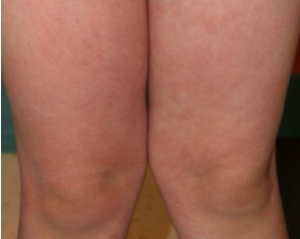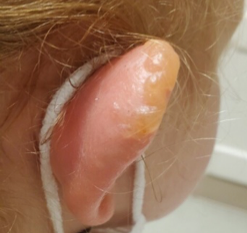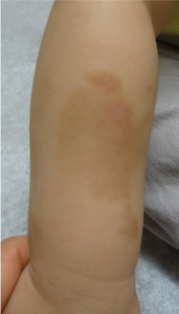Dermatology Tips and Tricks for Pediatricians
January 17, 2022

Preventing Sun Exposure in Children
One of the best things to do is to promote proper sun protection to prevent skin cancer. It is especially important to remind patients and parents of the following during warmer months when UV ratings are highest.1
- Mineral sunscreens with zinc oxide or titanium dioxide are immediately effective, making them the gold standard
- Broad spectrum chemical sunscreens are the next best option but are only effective beginning 30 minutes after application.
- Sunscreen with a minimum of 30 SPF should be used even when in the car or on cloudy days and should be reapplied every 1-2 hours.
- In general, we recommend lotions and sticks over sprays due to challenges with adequate application when using sprays.
Managing Sun Sensitivity in Pediatric Patients
Some medications frequently prescribed to pediatric patients can make them more sensitive to the sun. When seeing patients with complaints of increased sunburn frequency or erythematous rash on sun-exposed areas who are taking the following drugs, provide education on sun protection and include medication-induced sun sensitivity on your differential.2
- NSAIDs, especially piroxicam and ketoprofen
- Tetracyclines, especially doxycycline
- Sulfonamides
- Fluoroquinolones
- Retinoids (topical or oral)
- Phenothiazines (first generation antipsychotics)
- St. John’s wort
Spotting Pediatric Sun-Induced Rashes and Reactions
Sometimes, sunlight can trigger rashes that are benign but important to recognize. Be sure to include the following common photodermatoses on your differential for pediatric rash.2
- Polymorphous light eruption (PMLE): the most common photodermatitis; presents as itchy papules, papulovesicles, and/or plaques in sun-exposed areas hours after sun exposure and can last for days-weeks. Usually occurs with first exposure to intense sun and improves as summer progresses.
- Juvenile spring eruption: a PMLE variant and thus is similar in the timing and progression of the eruption, but the eruption usually consists of erythematous papules and bullae and is classically located on the helices of the ears.
*Treatment for both conditions involves proper sun protection, or sun avoidance, and treating the itch with emollients or topical steroids as both conditions self-resolve but may recur. Sometimes oral steroids are needed.
- Phytophotodermatitis: When left on the skin, certain plant species including lemons, limes, celery, wild parsnip, and parsley react to the sun leading to erythema, edema, and bullae in linear or other distinct patterns (i.e. a hand print) 24 hours after exposure.
- When to Worry: While the most common sun-reactions you will encounter are benign, the following things are red-flags for more serious, systemic reactions to the sun such as lupus, dermatomyositis, or porphyria
- Presence of other organ dysfunction such as muscle weakness, joint pain/swelling, abdominal pain, transaminitis, and/or evidence of nephritis.
- Classic systemic rash presentations such as malar rash for lupus, Gottron’s papules for dermatomyositis, and purpuric edematous plaques for erythropoietic porphyria.
Learn more about the Boston Children’s Dermatology Program.
Resources
1. Elmets, C.A. (2021). Overview of cutaneous photosensitivity: Photobiology, patient evaluation, and photoprotection. In T.W. Post, R.P. Dellavalle, & J. Callen (Eds.) UpToDate. Available from: https://www-uptodate-com.umassmed.idm.oclc.org/contents/overview-of-cutaneous-photosensitivity-photobiology-patient-evaluation-and-photoprotection?search=polymorphous%20light%20eruption&topicRef=6623&source=see_link
2. Elmets, C.A. (2021). Photosensitivity disorders (photodermatoses): Clinical manifestations, diagnosis, and treatment. In T.W. Post, R.P. Dellavalle, & J. Callen (Eds.) UpToDate. Available from: https://www-uptodate-com.umassmed.idm.oclc.org/contents/photosensitivity-disorders-photodermatoses-clinical-manifestations-diagnosis-and-treatment?search=photosensitizing%20drugs&source=search_result&selectedTitle=1~150&usage_type=default&display_rank=1
3. Elmets, C.A. (2021). Polymorphous Light Eruption. In T.W. Post, R.P. Dellavalle, & J. Callen (Eds.) UpToDate. Available from: https://www-uptodate-com.umassmed.idm.oclc.org/contents/polymorphous-light-eruption?search=polymorphous%20light%20eruption&source=search_result&selectedTitle=1~32&usage_type=default&display_rank=1
4. Merola, J.F. (2019). Overview of cutaneous lupus erythematosus. In T.W. Post, D.S. Pisetksy, & J. Callen (Eds.) UpToDate. Available from: https://www-uptodate-com.umassmed.idm.oclc.org/contents/overview-of-cutaneous-lupus-erythematosus?search=sle&source=search_result&selectedTitle=4~150&usage_type=default&display_rank=4
About the Author
Jennifer Huang, MD, is section chief of Dermatology at Boston Children’s Hospital; director of Pediatric Oncodermatology; program director of the Harvard Combined Dermatology Residency Program; and associate professor of Dermatology at Harvard Medical School.





